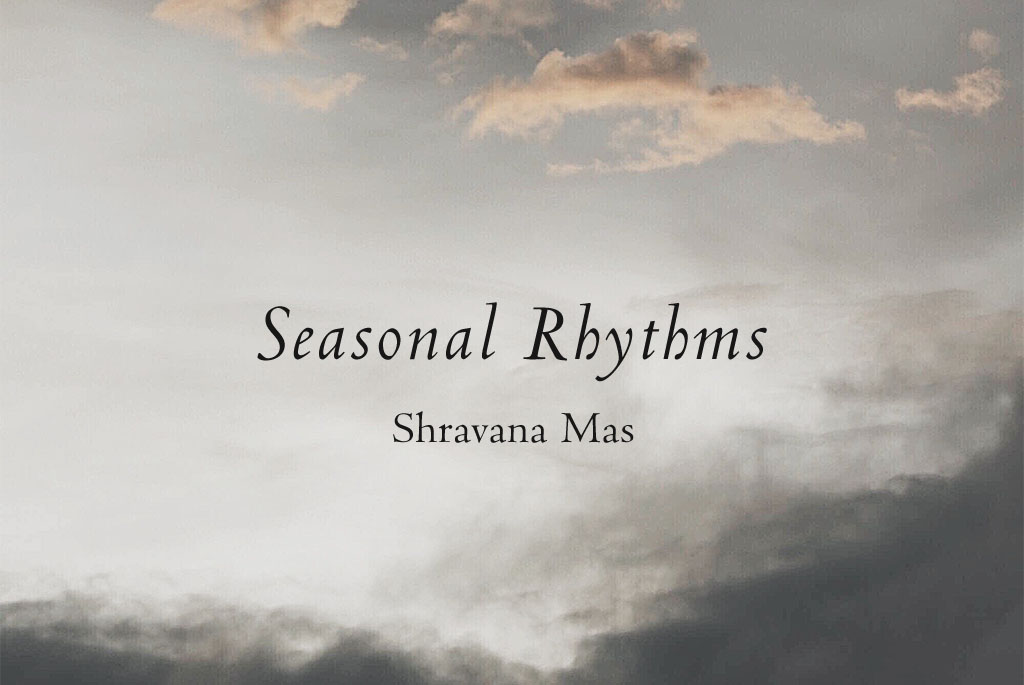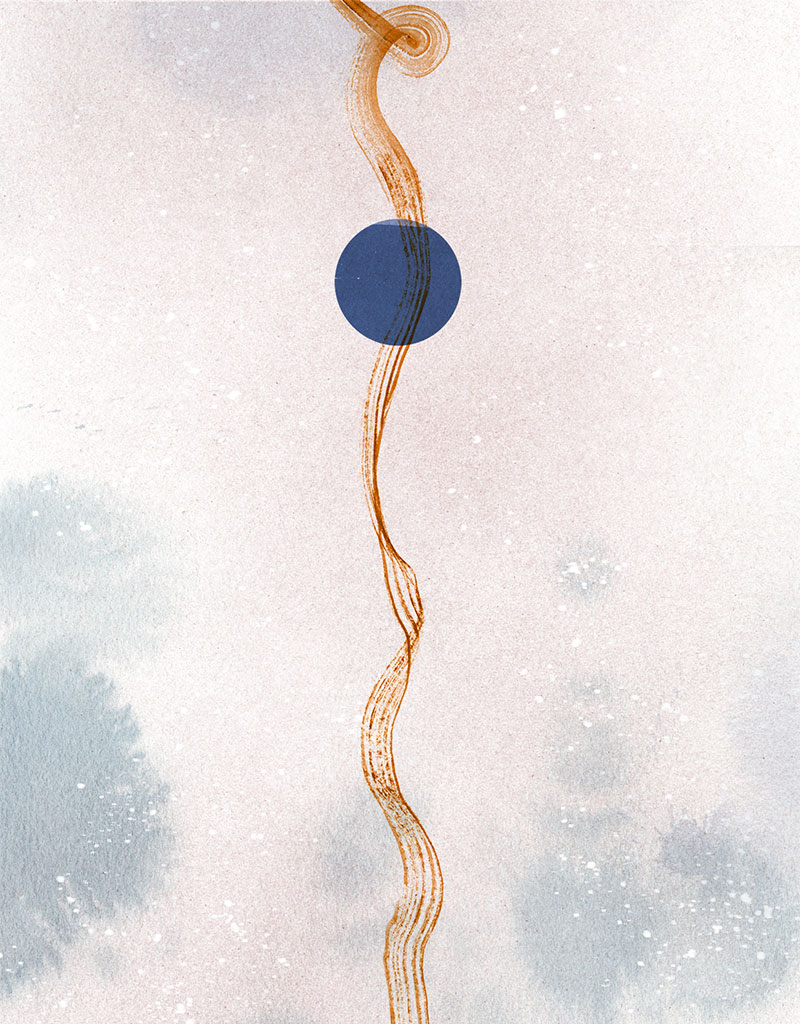Nilakshi Sharma

The month of Shravan ushers in the most dramatic and unique season of the subcontinent – monsoon or Varsha rtu. Ritually, culturally, economically and agriculturally this season of rains holds enormous significance.
Former President of India, Pranab Mukherjee, once remarked that monsoon season was India’s true finance minister. From the Vedic age onwards, Varsha rtu has been venerated, celebrated and even feared as a season. Monsoon is the time of life-giving waters – replenishing the rivers, quenching the thirst of the earth after the scorching heat of summer. The first sighting of the dark rain coloured, water laden clouds rolling in over the Arabian sea is eagerly awaited. Today a good monsoon means a good economic year. But long before that a good monsoon meant that the balance between the seasons and therefore the natural rhythms of the earth remained intact, that the sacred and the secular were in harmony.
Amongst the earliest recorded mentions of seasons and months in Vedic literature, Shravan and Bhadrapada were known as ‘Nabha and Nabhasya’ - the ‘Clouds and Skies of the rainy months’. This season of water is characterised by dramatic beauty of the skies. Storm tossed dark clouds, heavy with water; lighting and thunder heralding the arrival of the season, the way the very light seems to be filtered through a blue lens, the scent of the water laden breeze that tickles the senses even before the rains begin… there is a dramatic beauty to this season that is unparalleled. As is its impact on our senses and being. Our bodies instinctively respond to this seasonal shift in energy, thrumming with joy as the scorching, desiccating heat of the summer disappears. It is no surprise then that Varsha rtu is possibly the most celebrated of all the seasons in art forms such as music, painting, poetry, etc. Many of the motifs that we find across traditional design forms, such as the Peacock are also closely linked to this season. But perhaps the most celebrated association with monsoon is that of love. Varsha rtu is the season of love – of the lover’s reunion and of secret trysts between lovers. This is the season of longing being fulfilled, charging the season and all its depictions and descriptions with eroticism.
Varsha rtu is also the season of a palpable energy shift. With Karka Sankranti, July 16, the time of Sun – Uttarayana, gives way to the time of the Moon – Dakshinayana, which is also celebrated as the time of the feminine energy. Just as the Sun governs light and expansive energy, the Moon governs the darkness of the night and the fluid energy of water. Varsha rtu is the first of the seasons of the feminine half of the year.
Rituals of Food
While the waters of monsoon are a welcome relief after the drying summer heat, it is also a time of weakened agni because according to Ayurveda, our digestive agni is at its weakest during the months of Shravan and Bhadrapada. All three doshas – Pitta, Vata and Kapha can become vitiated during this season.
Thus, we need to nurture our digestion and build our body strength carefully during this season. In Ayurveda monsoon is the right time for body detox regimens such as the Panchkarma treatment.
- Tridoshic Foods: It is good to opt for foods that help balance all three doshas such as Khichri. Choose warm, lightly cooked, easy to digest meals. Grains like Rice and Barley are recommended. Raw leafy vegetables, nuts, etc., which are heavy and require digestive effort should be avoided at this time.
- Honey: Regular consumption of small amounts of Honey is traditionally recommended during the monsoon season.
- Sour, salty and sweet are the three tastes recommended in this month. Foods with a sour taste such as the Amla or Gooseberry offer the elements of Earth and Fire. Salty taste offers the elements of Water and Fire. Sweet taste combines the elements of Earth and Water. Foods that have an unctuous quality are also recommended in small quantities. As per many experts Cow Ghee is the best to consume in this category of unctuous foods.
- The use of spices such as Ginger, which is a warming spice that encourages our digestive agni is ideal. Some gentle ways to support and strengthen the digestive system include:
- A cup of Ginger tea – a teaspoon of freshly grated Ginger steeped in hot water, before a lunch can help to gently stimulate digestion, thereby strengthening our digestive fire.
- Have a cup of the tridoshic Cumin, Coriander & Fennel tea post dinner. This can help strengthen the digestive fire, increase elimination of waste and improve gut health, decrease bloating, acidity and flatulence, and help with inflammation. To make, combine a teaspoon each of Coriander, Cumin and Fennel seeds in a saucepan. Add 2 cups of water, cover and simmer on a low flame till quantity of water reduces to half. Strain and drink the tea.
Rituals of Self Care
Since the monsoon season is ideal for cleansing the body a practice like dry brushing or Garshana is ideal since dry brushing of the body as a regular routine is a simple way of encouraging lymphatic drainage in the body. It also improves circulation and exfoliates the skin.
Use a body brush with natural bristles or a natural loofah. Always perform Garshana on a dry body. Starting with your feet, gently brush upwards in short strokes. Repeat with hands, back and torso. Always remember to brush in the direction of your heart, never away from it. Be gentle. The lymph system is near the surface of the skin so stimulating it does not require too much pressure. After brushing bathe as normal and then moisturise your skin with a light but nourishing body oil such as Apricot or Almond oil.
Caution: Never brush away from your heart, all brush strokes should be towards the heart. Not recommended on the same day with Abhyanga (self-massage with warm oil).
Meditation: The season of rains is the first season of the feminine half of the year – Dakshinayana. This is traditionally a time of turning our focus inwards, when we are encouraged to undertake ritual practises that help our spiritual, emotional and inner growth. Meditation, with your own preferred meditation practice rituals, is highly recommended. What is important is that we turn to it with regularity and make our meditation practice a routine. Incense, sound bowls, fragrant fresh flowers, diyas, all of these can be fantastic aids that help us frame our mediation rituals.
Festive Rituals
The season of rains is dedicated to the deity Shiva. Traditional devotees fast on the Mondays of Shravan and Bhadrapada. Shiva’s consort Parvati is also worshipped and venerated in these months of Varsha rtu. The three Teej festivals - Hariyali, Kajari and Hartalika, are all dedicated to Shiva and Parvati. Hariyali Teej, which strongly emphasises the colour of fertility - green, is a celebration of Shiva and Parvati’s marriage. This year Hariyali Teej comes on 19 August 2023, while the Kajari and Hartalika Teej come in the month of Bhadrapada.
Shravan mas ends with two beautifully different festivals. The first is the widely celebrated bond between brothers and sisters – Raksha Bandhan, which is being celebrated on August 30. The other is one of the most beautiful and meaningful Full Moon rituals of the year – Nariyali Purnima, on August 31. The sea faring coastal community of Maharashtra celebrates this Purnima with an invocation to nearly forgotten Vedic deity – Varuna, he who rules the waters. The fisher folk offer him coconuts and seek his blessings in the form of a bountiful catch and protection when they are out in his dominion, the seas, to earn their daily livelihood. They round the ritual celebration by also honouring the earth which nurtures and nourishes them with her abundance. In acknowledgement of her, they ritually plant a tree on the Purnima as a part of the celebrations.
Adhik Mas
This year the traditional month of Shravan is unusual because it has the addition of an intercalary month, i.e., extra days are counted in this month in order to maintain harmony with the solar year. This addition is known as Adhik Mas. So, Shravan mas runs for a total of 57 days this year.
In the Gregorian calendar, which is purely Solar, the only intercalary day needed for the calendar to remain synchronous with the Solar cycle is the extra day added to February every fourth year, which is then known as the leap year. In the Luni-Solar calendar, which is the traditional Panchang calendar, the difference of approximately 10 days between the Solar calendar (365.2 days) and the Lunar calendar (354.3 days) is reconciled by the addition of an extra month – Adhik Mas every third year.





